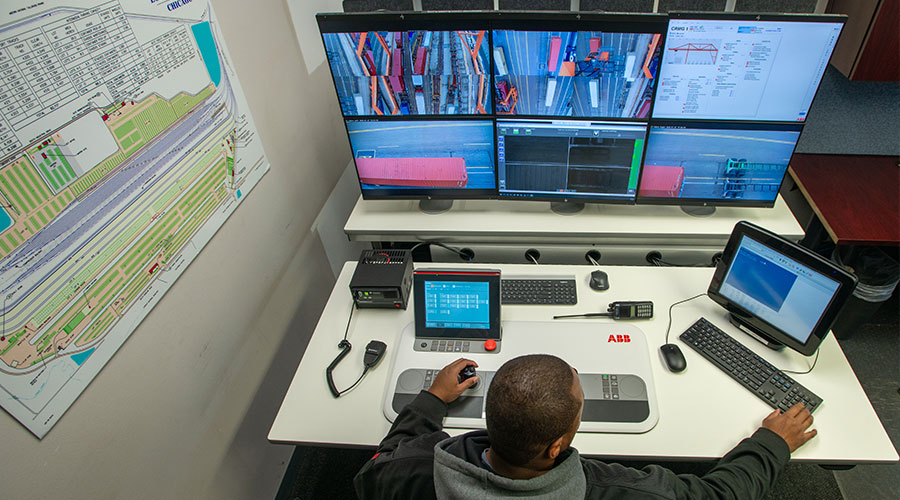Another wide-span crane first for BNSF: Wireless remote-control operation
1/8/2024
By Jeff Stagl, Managing Editor
In 2007, BNSF Railway Co. became the first North American railroad to employ wide-span electric cranes at intermodal terminals. The Class I now operates 26 of the cranes, which reduce the number of diesel hostler trucks needed to shuttle containers because of their wide stance and range of motion.
Last year, BNSF chalked up another wide-span crane milestone. The Class I became the first North American railroad to develop and test a wireless remote-control system for the major container-lift equipment.
In summer 2023, BNSF began using the wireless system on six wide-span cranes at its Logistics Park Chicago (LPC) intermodal facility in Elmwood, Illinois. Located near Chicago, the facility performs more than 1 million container lifts per year.
 An operator stationed in an office relies on a joystick, computer and monitors to remotely control a wide-span crane. Operators tap into a wireless system that features cameras and software. BNSF Railway Co.
An operator stationed in an office relies on a joystick, computer and monitors to remotely control a wide-span crane. Operators tap into a wireless system that features cameras and software. BNSF Railway Co.The system features cameras, software and other technologies to mirror a crane operator’s cab environment so a crane can be remotely controlled via a joystick, computer and monitors stationed at an office desk.
The primary benefits are safety, productivity and efficiency gains, and reduced operator downtime, says BNSF Vice President of Service Design Jon Gabriel.
Previously, when a crane operator came on duty at LPC, he or she was driven by a van about 1.5 miles to a wide-span crane, which typically took 15 minutes. The operator then needed to climb four flights of stairs to reach the 45-foot-high cab. Operators receive three breaks including lunch, so they might descend and climb the stairs several times during a shift.
Since there are three operator shifts per day and six cranes at LPC, the efficiency gains from the wireless remote-control systems are significant, says Gabriel.
“You end up saving ... one hour of downtime for each crane for each shift and three shifts a day,” he says. “In other words, it’s like saving 18 hours of productivity per day, or the equivalent of a seventh crane without having to buy or build that seventh crane.”
The system also boosts LPC’s capacity by about 14% and enables continuous hostler workflow, which helps improve service for customers, Gabriel says. Plus, the work environment is safer for operators since they are stationed in an office and no longer need to access a series of stairs frequently.
 Crane operators at Logistics Park Chicago previously needed to be driven to their work site and then climb four flights of stairs to reach the cab. BNSF Railway Co.
Crane operators at Logistics Park Chicago previously needed to be driven to their work site and then climb four flights of stairs to reach the cab. BNSF Railway Co.BNSF worked with Buckeye Mountain — a mobile wireless solutions provider — to develop the wireless remote-control system. A co-patent is pending, says Gabriel.
Latency — or how fast a remote-control command is recognized by equipment — is an issue with any wireless solution, and BNSF and Buckeye Mountain were able to get the crane system’s latency to a fraction of a second, he says.
BNSF began using the system on one crane at LPC in 2022 to test the waters with the wireless solution. Crane operators provided feedback, which helped determine optimal camera angles and other criteria, says Gabriel. Now, a majority of the operators — which need to obtain remote-control certification — prefer using the system and working in an office environment.
In 2024, BNSF plans to install the remote-control system on wide-span cranes at its Memphis, Tennessee, intermodal terminal and Logistics Park Kansas City facility. Next year, the railroad expects to do the same at its Seattle intermodal terminal.
Along with LPC, the three intermodal facilities are the only BNSF terminals that employ wide-span cranes. Since those cranes are rail-mounted, they are prime candidates for the wireless remote-control system, says Gabriel. But the technology is scalable.
The next step for the system: installing it on rubber-tired cranes, which account for the vast majority of lift equipment at terminals. Cranes would no longer need to be tethered to an operation because of the wireless technology’s data platform.
“We have 1,000 pieces of lift equipment across the network,” says Gabriel. “The next iteration could be a semi-autonomous operation where the crane moves itself and the operator gets the next box.”
The result would be continuous container lifts and drops — a big boon for customers, he adds.
For now, the wireless remote-control technology is both a current system that provides the equivalent of an extra wide-span crane in productivity and a futuristic system that promises additional uses.
It’s another technological advance for BNSF that’s aimed at getting containers in and out of intermodal terminals more quickly to continually improve the customer experience, says Gabriel.


